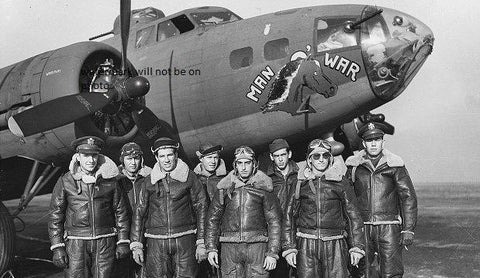The Evolution of the Aviator Jacket: From Military Necessity to Timeless Fashion Icon

The aviator jacket, also known as the flight jacket or bomber jacket, is a classic piece of clothing that has transcended its utilitarian roots to become a symbol of style and rebellion. From the icy winds of high-altitude flying to the runways of high fashion, the journey of the aviator jacket is as dynamic as the garment itself.
Origins of the Aviator Jacket
The aviator jacket’s history is firmly rooted in the early days of aviation. In the early 20th century, planes were open-cockpit, and pilots had little protection from the elements. To combat freezing temperatures at high altitudes, there was a clear need for specialized gear that would offer warmth, durability, and freedom of movement.
In 1917, during World War I, the U.S. Army’s Aviation Clothing Board was formed to develop suitable outerwear for pilots. The result was the introduction of the first leather flight jackets, crafted from sturdy materials like sheepskin and leather. These early versions featured high collars, snug cuffs, and heavy-duty zippers, which became the hallmark of aviator jackets in years to come. This practicality not only kept pilots warm but also added a rugged, stylish aesthetic that would later catch the eye of the fashion world.
See also: Shearling Leather vs. Traditional Leather: Which Jacket Is Right for You?
The Iconic A-2 and B-3 Jackets
The aviator jacket truly entered popular culture during World War II with the development of the A-2 and B-3 flight jackets. The A-2 jacket, introduced in the 1930s, featured a more refined design with a front zipper, ribbed cuffs, and a fitted waist. Made from horsehide or goatskin leather, it was tough yet comfortable, making it a favorite among U.S. Army Air Corps pilots.
Shortly after, the B-3 jacket was developed for bomber crews, who flew at even higher altitudes and colder temperatures. The B-3 was heavily insulated with shearling lining, offering maximum warmth. Its bulkier design, fur collar, and rugged look made it an instant classic, and it remains one of the most iconic versions of the aviator jacket to this day.
These jackets were not only functional; they also became symbols of the brave men who wore them. Pilots would often personalize their jackets with patches, insignias, and artwork, adding a touch of individuality to their standard-issue gear. As returning soldiers brought their jackets home, they began to symbolize heroism, adventure, and masculinity, paving the way for their entry into mainstream fashion.
Post-War Influence on Fashion
After World War II, military surplus clothing, including flight jackets, became readily available to the public. Civilians began to adopt these jackets for everyday wear, and soon, they were embraced by various subcultures. The tough, masculine look of the aviator jacket made it a favorite among bikers, who appreciated its durability and timeless appeal.
In the 1950s and 60s, Hollywood also played a significant role in popularizing the aviator jacket. Iconic stars like Marlon Brando, James Dean, and Steve McQueen frequently donned flight jackets in films, adding an element of rebellious cool to the garment. These actors became style icons, and the aviator jacket was cemented as a symbol of rugged independence.
The 1980s Boom: Top Gun and Beyond
The 1980s saw a resurgence in the popularity of the aviator jacket, thanks in large part to the blockbuster film Top Gun (1986). Tom Cruise’s character, Maverick, sporting a G-1 flight jacket with patches, reignited interest in the military-inspired style. The film not only drove sales of aviator jackets but also made aviator sunglasses a must-have accessory.
Fashion designers, recognizing the timeless appeal of the aviator jacket, began incorporating it into their collections. Brands like Ralph Lauren, Gucci, and Burberry all produced their versions of the iconic jacket, blending high fashion with military-inspired design. The versatility of the aviator jacket, able to be dressed up or down, made it a staple in both men’s and women’s wardrobes.
The Aviator Jacket in Modern Fashion
Today, the aviator jacket continues to be a popular fashion item, frequently appearing on runways and in streetwear collections. While classic leather versions remain timeless, contemporary designers have reimagined the jacket in new fabrics, colors, and cuts. From lightweight nylon to vegan leather, the aviator jacket has evolved to suit modern tastes while retaining its original charm.
Celebrities and fashion influencers have kept the jacket in the spotlight, with stars like Rihanna, Kanye West, and Gigi Hadid often spotted sporting updated versions of the classic aviator jacket. It remains a versatile piece, capable of being styled with jeans for a casual look or paired with tailored pieces for a more polished appearance.
The Appeal of the Aviator Jacket: Why It Endures
What makes the aviator jacket such a beloved fashion staple after more than a century? Part of its appeal lies in its history. It’s a garment steeped in nostalgia, conjuring images of daring pilots, Hollywood icons, and rebellious youth. But beyond its cultural significance, the aviator jacket is simply practical and stylish.
Its design—rugged yet sleek—offers a perfect balance between form and function. The classic silhouette flatters most body types, while the durable materials ensure that the jacket can stand the test of time. Whether it’s the warmth of a shearling-lined B-3 or the lightweight versatility of an A-2, the aviator jacket offers something for everyone.
FAQs
Where did the aviator jacket originate?
The aviator jacket originated during World War I when pilots needed protection from cold temperatures at high altitudes. The U.S. Army developed leather flight jackets to keep airmen warm in their open cockpits.
What is the difference between an A-2 and a B-3 jacket?
The A-2 is a lighter leather jacket introduced in the 1930s, while the B-3 is a heavily insulated shearling jacket designed for bomber pilots who flew at higher altitudes.
How did Top Gun influence aviator jacket fashion?
The release of Top Gun in 1986 popularized the aviator jacket in mainstream fashion, especially the G-1 jacket worn by Tom Cruise’s character, Maverick.
Why is the aviator jacket still popular today?
The aviator jacket remains popular due to its timeless design, durability, and cultural significance. It can be styled in a variety of ways, making it a versatile fashion staple.
What materials are modern aviator jackets made from?
While traditional aviator jackets are made from leather or shearling, modern versions can also be found in materials like nylon, vegan leather, and even denim.
Who are some celebrities known for wearing aviator jackets?
Celebrities like Tom Cruise, Rihanna, Kanye West, and Gigi Hadid have all contributed to the aviator jacket’s enduring popularity by wearing them in both casual and high-fashion settings.
The aviator jacket has undoubtedly earned its place in fashion history. What began as essential military gear has transformed into a symbol of style and confidence, making it a wardrobe staple that never goes out of fashion.



